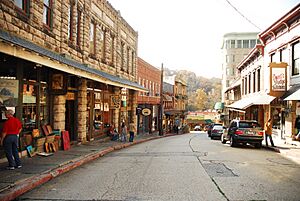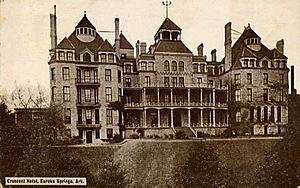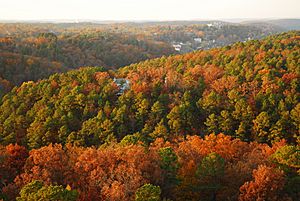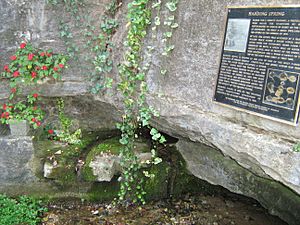Eureka Springs, Arkansas facts for kids
Quick facts for kids
Eureka Springs, Arkansas
|
|
|---|---|

Spring Street
|
|
| Nicknames:
"Eureka", "Little Switzerland of America", "The Stairstep Town"
|
|

Location within Carroll County and Arkansas
|
|
| Country | United States |
| State | Arkansas |
| County | Carroll |
| Incorporated | 1880 |
| Government | |
| • Type | Mayor–council government |
| Area | |
| • Total | 6.90 sq mi (17.86 km2) |
| • Land | 6.76 sq mi (17.50 km2) |
| • Water | 0.14 sq mi (0.36 km2) |
| Elevation | 1,421 ft (433 m) |
| Population
(2020)
|
|
| • Total | 2,166 |
| • Density | 320.51/sq mi (123.75/km2) |
| Time zone | UTC−6 (CST) |
| • Summer (DST) | UTC−5 (CDT) |
| ZIP Codes |
72631–72632
|
| Area code | 479 |
| FIPS code | 05-22240 |
| GNIS ID | 2403579 |
Eureka Springs is a city in Carroll County, Arkansas, United States. It is one of two places that serve as the county seat for Carroll County. The city is in the Ozark Mountains of northwest Arkansas, close to the border with Missouri. In 2020, about 2,166 people lived there.
In 1970, the entire city was added to the National Register of Historic Places. This means its historic buildings and areas are protected. Eureka Springs is known as one of America's Distinctive Destinations. It was once called "The Magic City" and "Little Switzerland of the Ozarks". People also call it the "Stairstep Town". This is because of its hilly land and the winding, up-and-down streets.
The city is a popular place for tourists. It is famous for its unique Victorian style. People first came here because they believed the natural springs had healing powers. The city has steep, winding streets. These streets are full of old Victorian-style houses and large homes. The downtown area has many well-preserved Victorian buildings. They are mostly made of local stone. The streets curve around the hills and follow the land. Some buildings are unusual. For example, the Basin Park Hotel has entrances on different levels. The streets do not often cross at right angles, and there are no traffic lights.
Contents
History of Eureka Springs

How Eureka Springs Started
Native American stories talk about a Great Healing Spring in the Eureka Springs area. People from different native groups visited these springs for special purposes.
Later, European Americans also believed the springs had healing powers. They said the spring waters had magical effects. Dr. Alvah Jackson is known for finding the spring. In 1856, he said the waters from Basin Spring cured his eye problems. During the Civil War, Dr. Jackson set up a hospital in a local cave. He used the Basin Spring waters to treat his patients. After the war, he sold the spring waters as "Dr. Jackson's Eye Water."
In 1879, Judge J.B. Saunders, a friend of Jackson, said the spring waters cured his serious illness. Saunders told his friends and family about Eureka Springs. This made the town grow very quickly. In just over a year, the city changed from a small spa village to a big city. By the late 1800s, Eureka Springs was a busy city, spa, and tourist spot.
Growth and Development
Eureka Springs officially became a city on February 14, 1880. Thousands of visitors came because of Saunders' stories. They set up tents and small shelters everywhere. By 1881, Eureka Springs was the fourth largest city in Arkansas. By 1889, it was the second largest, after Little Rock.
After being a governor, Powell Clayton moved to Eureka Springs. He helped promote the city and its businesses. Clayton wanted the town to be a place for wealthy people to retire. Soon, Eureka Springs became known for its fancy lifestyle.
In 1882, the Eureka Improvement Company was created. Its goal was to bring a railroad to the city. When the railroad was finished, Eureka Springs became an even more popular vacation spot. In just two years, many homes and businesses were built. The Crescent Hotel was built in 1886. The Basin Park Hotel followed in 1905. These many Victorian buildings have been kept in good condition. They create a beautiful street view that is well-known. In 1892, the New Orleans Hotel and Spa was built. Today, it is an all-suite hotel with Victorian furniture and art.
Eureka Springs in the 1900s
The Ozarka Water Company started in Eureka Springs in 1905. Carrie Nation, a famous activist, lived here later in her life. She founded Hatchet Hall on Steele Street. This building was once a museum but is now closed.
The only bank robbery in Eureka Springs happened on September 27, 1922. Five criminals from Oklahoma tried to rob the First National Bank. Three of them were killed, and two were hurt.
In 1950, Opera in the Ozarks at Inspiration Point was founded. This group still holds an opera festival in Eureka Springs every summer. In 1967, the famous 7-story Christ of the Ozarks Statue was built. A year later, The Great Passion Play began. This is an outdoor show performed from May to October. It has 170 actors and many live animals. About 7.7 million people have seen it. This makes it the most-watched outdoor play in the United States.
Other Christian-themed attractions have been added. These include a New Holy Land Tour. It has a full-size copy of the Tabernacle in the Wilderness. There is also a piece of the Berlin Wall and a Bible Museum. The museum has over 6,000 Bibles. Some items include an original 1611 King James Bible and a page from a Gutenberg Bible.
In 1980, the architect E. Fay Jones designed Thorncrown Chapel. In 2006, it won the "Twenty-five Year Award" from the American Institute of Architects. This award is for buildings that have greatly influenced the profession. Because of its special design, the chapel was added to the National Register of Historic Places in 2000.
Eureka Springs in the 2000s
On May 10, 2014, Eureka Springs became the first city in Arkansas to issue marriage licenses to same-sex couples. On May 12, 2015, Eureka Springs passed a Non-Discrimination Ordinance (Ord. 2223). Voters approved it with 579 votes for and 261 against.
This made it the first city in Arkansas to have a law protecting LGBT residents and tourists. However, a state law later tried to cancel this local rule. This state law, called the Intrastate Commerce Improvement Act, stops cities from adding protections beyond state law. The mayor of Eureka Springs said they would fight to keep their ordinance in court.
Geography and Climate
Where is Eureka Springs?
Eureka Springs is in western Carroll County. The city's center is in a narrow valley. This valley is at the start of Leatherwood Creek, which flows north into the White River. Houses and streets go up both sides of the valley to the hilltops. U.S. Route 62 runs along a hilltop through the southern part of the city. It goes east 11 miles to Berryville and west 34 miles to Rogers. Arkansas Highway 23 is Main Street through the center of Eureka Springs. It goes north 11 miles to the Missouri state line.
The city was founded because of the many springs there. However, taking too much water from the springs has made their flow much smaller. All of the more than 140 springs in the town are cold-water springs.
What is the Climate Like?
The weather in Eureka Springs has hot, humid summers. Winters are usually mild to cool. According to the Köppen Climate Classification system, Eureka Springs has a humid subtropical climate. This is shown as "Cfa" on climate maps.
| Climate data for Eureka Springs, Arkansas (1981–2010 normals) | |||||||||||||
|---|---|---|---|---|---|---|---|---|---|---|---|---|---|
| Month | Jan | Feb | Mar | Apr | May | Jun | Jul | Aug | Sep | Oct | Nov | Dec | Year |
| Record high °F (°C) | 78 (26) |
81 (27) |
88 (31) |
96 (36) |
93 (34) |
101 (38) |
106 (41) |
105 (41) |
105 (41) |
91 (33) |
86 (30) |
76 (24) |
106 (41) |
| Mean daily maximum °F (°C) | 46.7 (8.2) |
51.9 (11.1) |
61.6 (16.4) |
71.7 (22.1) |
77.5 (25.3) |
84.0 (28.9) |
88.9 (31.6) |
89.5 (31.9) |
81.0 (27.2) |
69.1 (20.6) |
59.1 (15.1) |
48.0 (8.9) |
69.1 (20.6) |
| Mean daily minimum °F (°C) | 28.1 (−2.2) |
31.7 (−0.2) |
39.6 (4.2) |
48.7 (9.3) |
56.8 (13.8) |
64.4 (18.0) |
68.9 (20.5) |
67.9 (19.9) |
60.2 (15.7) |
49.2 (9.6) |
40.4 (4.7) |
30.1 (−1.1) |
48.8 (9.3) |
| Record low °F (°C) | −14 (−26) |
−8 (−22) |
2 (−17) |
21 (−6) |
35 (2) |
46 (8) |
51 (11) |
47 (8) |
34 (1) |
19 (−7) |
7 (−14) |
−15 (−26) |
−15 (−26) |
| Average precipitation inches (mm) | 2.64 (67) |
2.88 (73) |
4.39 (112) |
4.39 (112) |
5.10 (130) |
4.34 (110) |
3.58 (91) |
3.27 (83) |
4.61 (117) |
3.46 (88) |
4.31 (109) |
3.43 (87) |
46.41 (1,179) |
| Average snowfall inches (cm) | 3.8 (9.7) |
4.4 (11) |
2.6 (6.6) |
0.1 (0.25) |
0 (0) |
0 (0) |
0 (0) |
0 (0) |
0 (0) |
0.1 (0.25) |
0.3 (0.76) |
2.6 (6.6) |
13.8 (35) |
| Average precipitation days (≥ 0.01 in) | 7.1 | 8.0 | 9.9 | 9.9 | 11.8 | 10.2 | 8.2 | 7.4 | 8.1 | 6.5 | 8.4 | 8.2 | 103.6 |
| Average snowy days (≥ 0.1 in) | 2.4 | 2.6 | 0.9 | 0 | 0 | 0 | 0 | 0 | 0 | 0 | 0.2 | 2.0 | 8.2 |
| Source 1: NOAA | |||||||||||||
| Source 2: The Weather Channel | |||||||||||||
People of Eureka Springs
| Historical population | |||
|---|---|---|---|
| Census | Pop. | %± | |
| 1880 | 3,984 | — | |
| 1890 | 3,706 | −7.0% | |
| 1900 | 3,572 | −3.6% | |
| 1910 | 3,228 | −9.6% | |
| 1920 | 2,429 | −24.8% | |
| 1930 | 2,276 | −6.3% | |
| 1940 | 1,770 | −22.2% | |
| 1950 | 1,958 | 10.6% | |
| 1960 | 1,437 | −26.6% | |
| 1970 | 1,670 | 16.2% | |
| 1980 | 1,989 | 19.1% | |
| 1990 | 1,900 | −4.5% | |
| 2000 | 2,278 | 19.9% | |
| 2010 | 2,073 | −9.0% | |
| 2020 | 2,166 | 4.5% | |
| U.S. Decennial Census 2014 Estimate |
|||
Population in 2020
| Race | Number | Percentage |
|---|---|---|
| White (non-Hispanic) | 1,833 | 84.63% |
| Black or African American (non-Hispanic) | 10 | 0.46% |
| Native American | 33 | 1.52% |
| Asian | 24 | 1.11% |
| Other/Mixed | 140 | 6.46% |
| Hispanic or Latino | 126 | 5.82% |
As of the 2020 United States census, there were 2,166 people living in the city. There were 970 households and 501 families.
Fun Things to Do
Events and Festivals
Halloween is one of the busiest times in Eureka Springs. The weekend before Halloween, the city has its annual Eureka Springs Zombie Crawl. This is one of the biggest zombie parades in the country. The Nightmare in the Ozarks Film Festival also happens here in late October.
The May Festival of the Arts is a month-long celebration of art in Eureka Springs.
The Eureka Springs Food and Wine Festival is held every fall. It features different foods and wines.
The Eureka Gras Mardi Gras Extravaganza started in 2006. It is a Mardi Gras celebration like those in New Orleans. It includes parades and masquerade balls. The celebration begins in January on King's Day and ends on Mardi Gras day in February or March.
The city also hosts four "Diversity Weekends" for gay and lesbian events. There is also a week-long PRIDE celebration in June. Eureka Springs also has an annual UFO conference and several car shows.
Places to Visit

- Blue Spring Heritage Center
- Christ of the Ozarks
- Crescent Hotel
- Eureka Springs & North Arkansas Railway
- Lake Leatherwood Park
- Thorncrown Chapel
Education
Public Schools
The Eureka Springs School District provides public education. It includes:
- Eureka Springs High School (grades 9–12)
- Eureka Springs Middle School (grades 5–8)
- Eureka Springs Elementary School (Pre-Kindergarten–grade 4)
Private Schools
Private school options are:
- Clear Spring School (Pre-Kindergarten–grade 12)
- The Academy of Excellence (Pre-Kindergarten–grade 8)
Media and Filming
Local Media
For TV, Eureka Springs gets channels from Springfield, Missouri. Cable TV also offers channels from Fayetteville/Fort Smith and all four Little Rock stations. The local radio station is KESA.
Newspapers
- Carroll County News is published twice a week. It also prints visitor guides.
- Lovely County Citizen is a free newspaper. It publishes the Eureka Springs Visitors Guide.
- ES Independent started in July 2012. It is a free printed newspaper.
- Arkansas Democrat-Gazette Northwest Arkansas edition is the only daily newspaper in the area.
Filming Location
Several movies and TV shows have been filmed in Eureka Springs:
- The movie Pass the Ammo was filmed here. The Auditorium was used in many scenes. You can still see burn marks on the Auditorium from the movie's special effects.
- The movie Chrystal was filmed in Eureka Springs.
- Parts of the movie Elizabethtown were filmed here.
- The 1982 TV miniseries The Blue and the Gray was filmed around the area.
- The SciFi Channel's show Ghost Hunters looked into the Crescent Hotel. In one episode, they found evidence of ghosts there.
Transportation
Getting Around
There is no regular bus service within Eureka Springs. However, you can find intercity bus service from Jefferson Lines in nearby Berryville.
Main Roads
Famous People from Eureka Springs
Arts and Culture
- Elsie Bates-Freund: An artist who taught at the Summer Art School of the Ozarks in Eureka Springs.
- Candace Camp: A schoolteacher in Eureka Springs who became a romance novelist.
- Irene Castle: A silent film actress and dancer who spent her last years here.
- Crescent Dragonwagon: Helped start the Writers' Colony at Dairy Hollow and lived in Eureka Springs.
- Glenn Gant: A painter who lived much of his life in Eureka Springs.
- Julius Hegyi: A conductor and violinist who taught at Inspiration Point Fine Arts Colony.
- Ben Kynard: A jazz saxophonist born in Eureka Springs.
- Marla Shelton: A film actress from the 1930s and 1940s, born in Eureka Springs.
- Jonathan Stalling: A poet and expert in Chinese literature, raised in Eureka Springs.
Military
- Marcellus H. Chiles: A United States Army Captain and Medal of Honor winner, born in Eureka Springs.
Education
- Mary Carson Breckinridge: Founder of the Frontier Nursing Service, she taught at Crescent College and Conservatory.
Religion
- William Evander Penn: A Baptist minister who lived in Eureka Springs.
- Gerald L. K. Smith: A clergyman who retired to Eureka Springs and had the Christ of the Ozarks built.
Sports
- Pat Burrell: A Major League Baseball player, born in Eureka Springs.
See also
 In Spanish: Eureka Springs para niños
In Spanish: Eureka Springs para niños




